Seven Fires Dinner at Ruka’s Table and a Recipe for Burnt Oranges with Rosemary
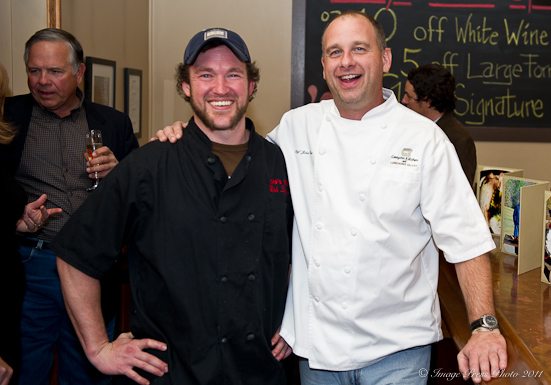
My last few articles have been about some of the events we attended during the Highlands Culinary Weekend. This evening was another very special dinner and of particular interest to us. The theme was inspired by the book, Seven Fires: Grilling the Argentine Way, which is about various open flame wood cooking methods used in South America. The evening’s dinner was prepared by Chef Mitch Sheppard of Ruka’s Table in Highlands, North Carolina and their guest chef, John Fleer of Canyon Kitchen in Cashiers, North Carolina.
When we interviewed John Fleer in July 2010, he told us about his fascination with this cooking method and the book, Seven Fires by Francis Mallmann. Mallmann is one of South America’s best known chefs. Trained in some of the finest kitchens in France, at age 40 he stopped cooking “fancy French food”, as Mallmann called it, and returned to his roots in Patagonia and began cooking in a very different way.
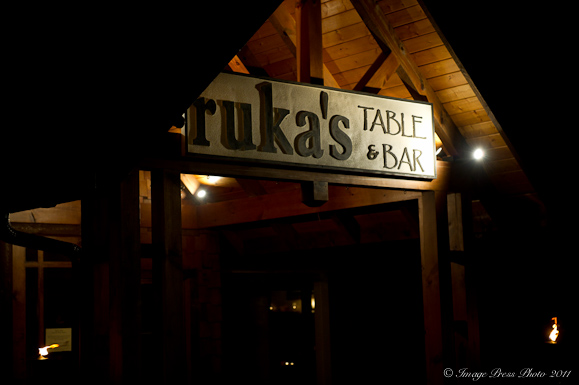
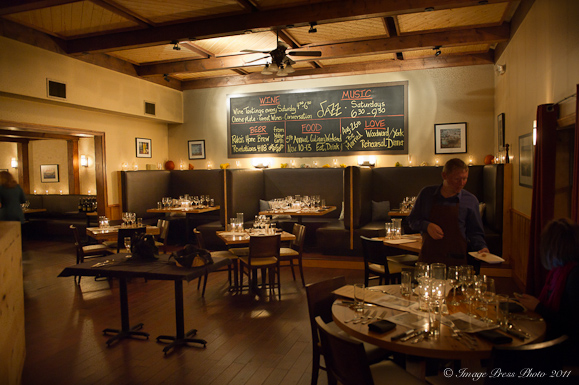
Mallmann’s book, Seven Fires, was inspired by the constant fires that Mallmann recalls in his home while growing up in the Andes. These fires heated everything from his family’s home, to their water and finally, it fed their large kitchen stove. The cuisine is also called Nuevo Andean. It is based on the wood fire and cast iron cooking that has been used for generations by the gauchos and Native Americans.
This method, combined with Mallmann’s extensive background in French cooking, brings out all the flavors and textures of the food, relying more on the cooking method and not complicated ingredients or sauces. Each of the methods uses varying degrees of flame or heat, depending on what type of food is being prepared.
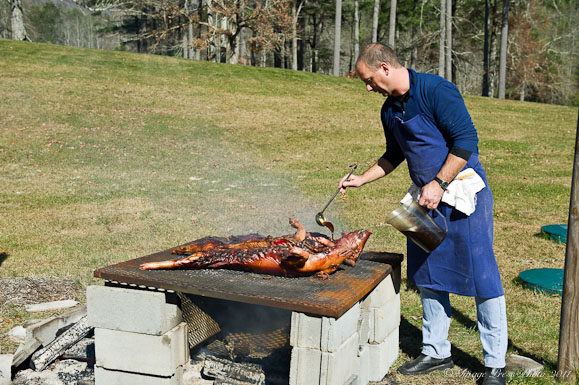
Chef John Fleer basting the suckling pig – This method of cooking is called Asador
“I adore dissonance in food – two tastes fighting each other. It wakes up your palate and surprises you. As you’ll see in many of the recipes in this book, charring or even burning adds an extra dimension to breads, vegetables, and fruit. The right amount of burning or charring can be delicious and seductive: a burnt tomato, for example, has a dark crust bordering on bitter, while the inside is soft and gentle in texture and taste.
What appeals to me is the element of danger and excitement in creating a burnt taste. Take the burning too far, and it destroys the dish. Stay just this side of the line, and it is lovely.” – Francis Mallmann
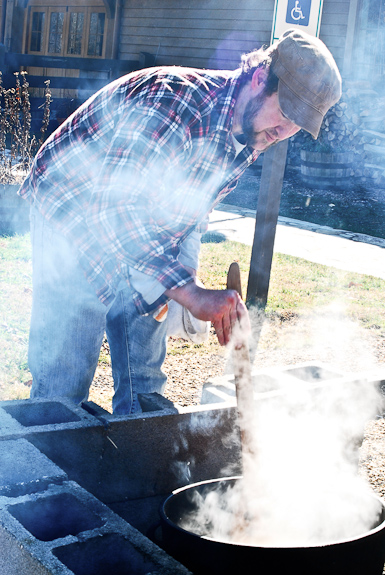
Chef Mitch Sheppard – Photo courtesy of Audra Thomas
Much of the cooking for this dinner was done earlier in the day due to the need for the outdoor fires and length of time for some of the preparation and cooking. We went over to Canyon Kitchen to meet with Chef Fleer to talk to him about the evening’s dinner and take some photos. Chef Sheppard split his time between Canyon Kitchen and Ruka’s Table during the day while preparing some of the other dishes for the evening’s dinner.
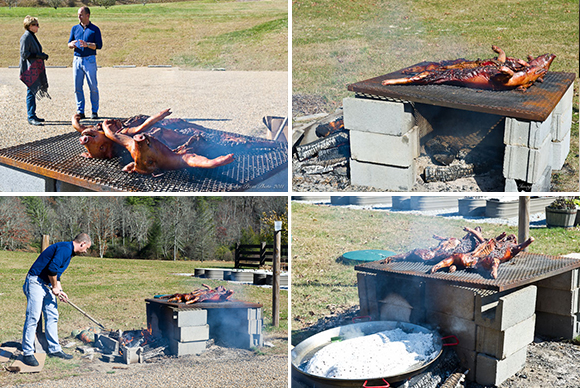
There were seven courses for dinner that evening and six of them were prepared by one of the Seven Fires methods of cooking over open fire. The only method of cooking not used for the dinner was Horno de Barro, which is cooking in an outdoor bread oven (similar to those in Tuscan kitchens).
The suckling pig that Chef Fleer was cooking and basting was prepared by the Asador method. This is how you cook whole animals (pigs, lambs or goats).
Fleer said that it had been quite mesmerizing watching the fires while he was cooking. I know that most of us enjoy sitting by a roaring fire on a cold evening. There is something almost seductive in the flames. I can understand the fascination with this cooking method and why some chefs would want to incorporate it in their dishes.
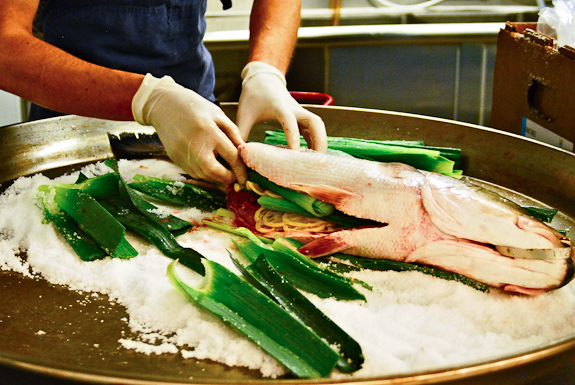
Prepping the Wild Striped Bass – Photo courtesy of Audra Thomas
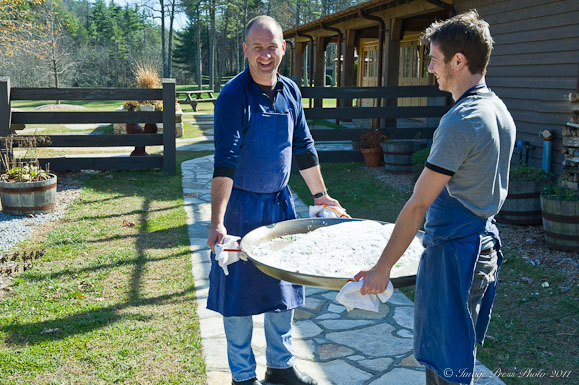
Chef Fleer with Chef Jason with the salt crusted fish
They were about to start cooking the Salt Roasted Wild Striped Bass when we left. This method, Infiernillo (or Little Hell), uses two fires with a cooking level in between and is used mainly for cooking large pieces of meat, whole fish or poultry encrusted in salt.
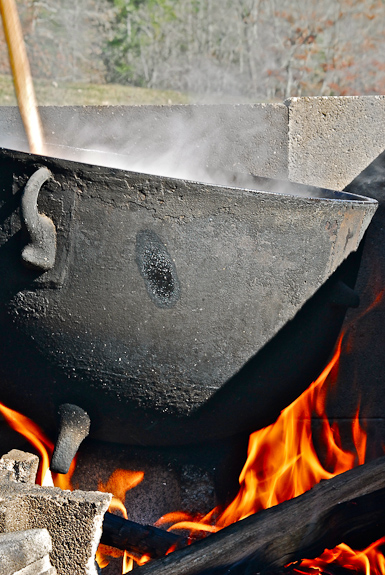
Caldero – Photo courtesy of Audra Thomas
The other dishes that evening included a Locro Stew & Chapa Bread that was prepared in a Caldero, which is a large cast-iron kettle or Dutch oven. This pot sits directly on the fire or bed of coals or ashes, depending on the amount of heat desired.
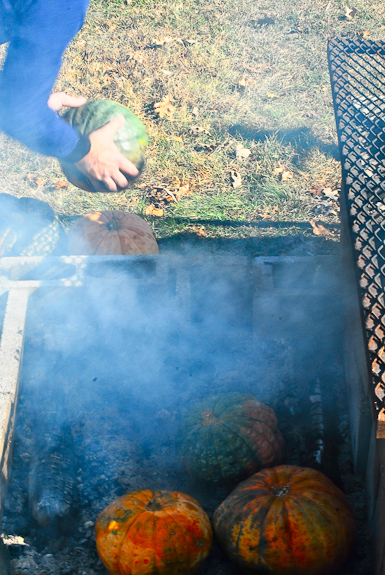
The squash are cooked directly in the ashes – Photo courtesy of Audra Thomas
One of our favorite dishes of the evening was the Ember Roasted NC Candy Roaster Squash. This squash was filled with a salad that included Jolley Farms greens, Looking Glass Chèvre, Benton’s Prosciutto, and Pear-Sweet Sheer Vinaigrette. This cooking method, Rescoldo, puts the squash directly in the ashes to cook it. You can see the ashes on the outside of the squash when it was served. The flavors were remarkable in this dish.
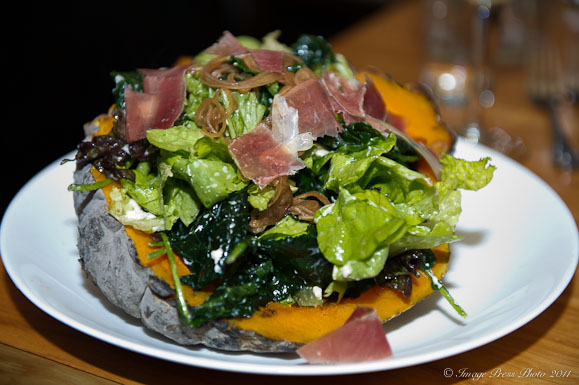
Ember Roasted NC Candy Roaster Squash
Other courses for the evening’s dinner and methods of cooking included:
Cast Iron Scallops with Clams – Chapa – a flat piece of cast-iron set over a fire.
East Forks Lamb – Parilla -a cast-iron barbecue grate set over hot coals.
Dessert was a Dulce de Fuego which was a Fire Roasted Rosemary Dulce de Leche with Pears Quemada, Puffed Quinoa Crisps, Torched Marshmallow and Dark Chocolate Sorbet.
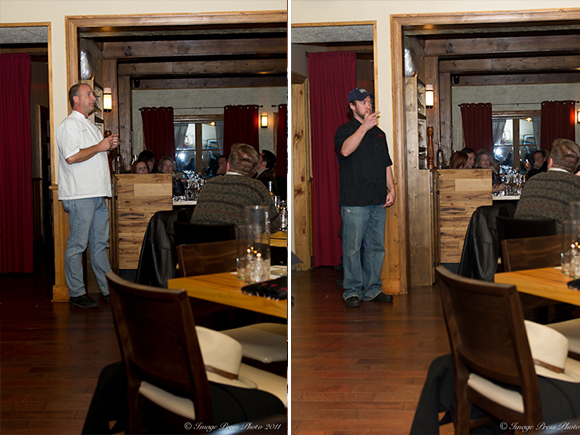
Both chefs came out to tell out about each of the courses and the method of cooking
Each course was paired with some excellent wines from Davis Family Vineyards from Sonoma, California. This small family winery is located in the beautiful Russian River Valley. Guy Davis shared his wines with the guests and explained the flavors and pairings with each course.
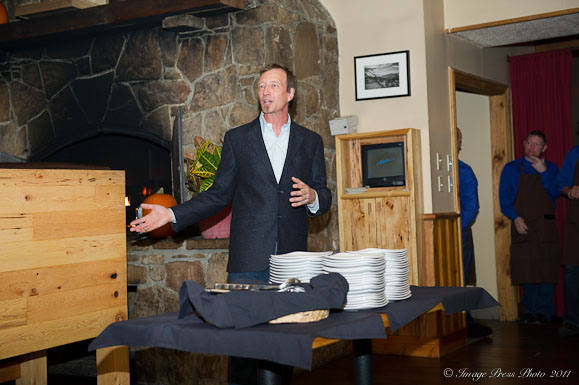
Guy Davis of Davis Family Vineyards
It was fascinating to see the method of cooking earlier in the day and how it translated to the dinner that evening. Thank you so much to Chefs Mitch Sheppard and John Fleer and the staff at Ruka’s Table for a truly memorable evening.
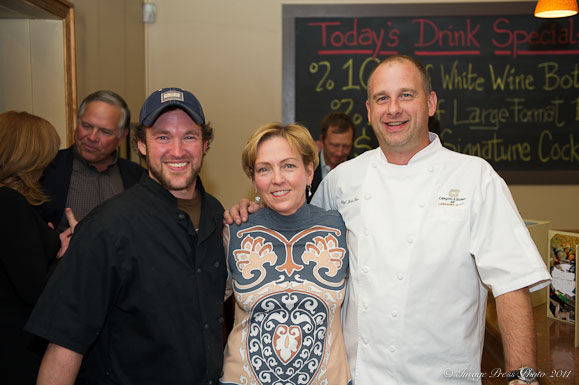
With Chefs Mitch Sheppard and John Fleer
I purchased the Seven Fires book after our interview with John Fleer last year. While the primary method of cooking in the book is with an open wood fire, Mallmann has modified many of these recipes so they can be prepared in your kitchen in a cast iron skillet. They do not all require an outdoor fire pit or grill.
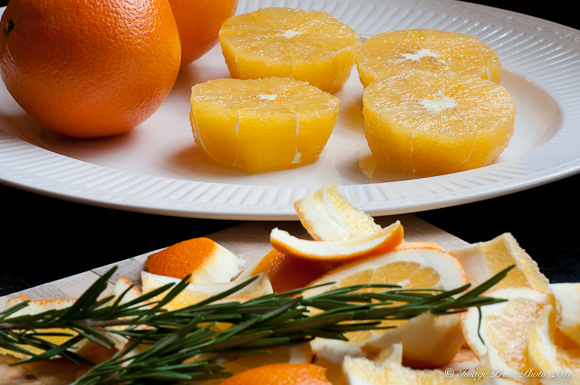
Preparing the oranges
I chose a recipe that Mallmann says is one of his easiest, however, he goes on to say that “the flavors and texture- bitter, sweet, fruity, floral, herbal, and smoothly creamy – are supremely intense and complex.” While he recommends preparing this outdoors due to the amount of smoke it creates, if you have a good ventilating system, a cast iron skillet over a medium-high heat works extremely well.
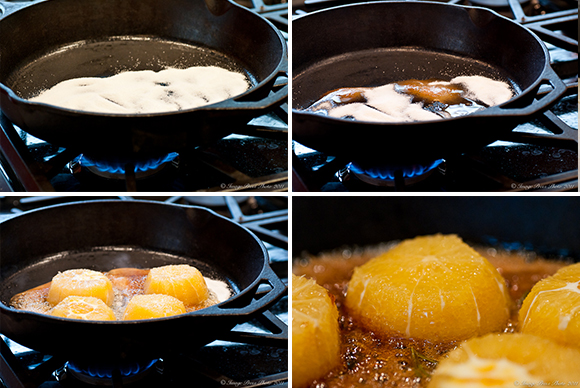
We loved the flavors in this dessert. There is that right mix of charring the citrus that Mallmann refers to. It was cooked perfectly without crossing over that line where it becomes overly burned. This is a simple yet elegant dessert and quite impressive to serve to company during the holidays.
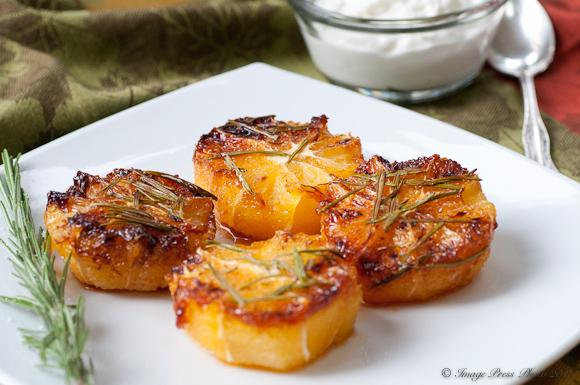
Beautifully charred – there are the sweet, bittersweet and herbal notes combined in this dish
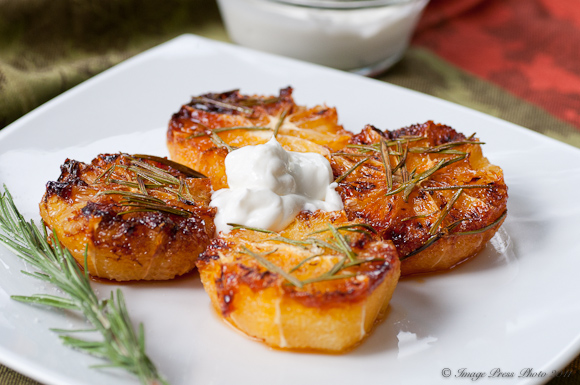
Served with Greek Yogurt, this adds another level of flavor to the dessert
I would highly recommend reading more about these cooking techniques and trying some of the other recipes in Mallmann’s book, Seven Fires. It is far more than a cookbook. Mallmann shares stories about his life with the reader and his inspiration for this book. He also explains these cooking methods in depth. I now know why John Fleer was so fascinated with Francis Mallmann and the Seven Fires and why he and Mitch Sheppard were inspired to create this dinner.
* Disclosure – We were guests of Ruka’s Table for this dinner. The opinions expressed are our own and we were not compensated for writing this article.
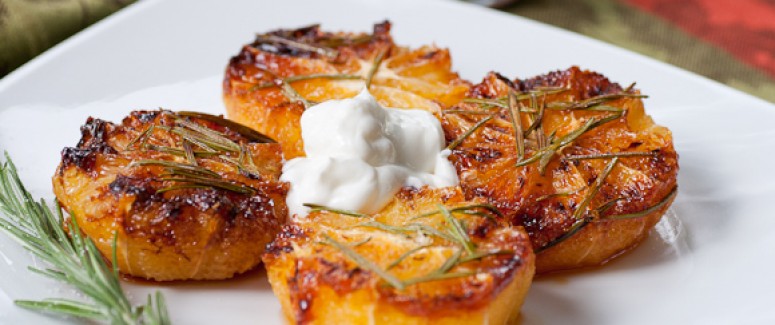
Burnt Oranges with Rosemary
Ingredients:
4 oranges
2 tablespoons fresh rosemary leaves
1/2 cup sugar
1 cup plain thick Greek yogurt
Directions:
1. Cut both ends off the oranges. One at a time, using a sharp paring knife, remove the peel and all the white pith from each orange in strips, working from top to bottom all the way around the orange. Cut the oranges crosswise in half and plate them on a plate cut side up.
2. Sprinkle the rosemary leaves over the oranges, and push some of the rosemary leaves into them so they adhere. Sprinkle half the sugar on top.
3. Heat a chapa or large cast iron skillet over medium-high heat. Spread the remaining sugar on the cooking surface and when it begins to melt, put the oranges cut side down on the sugar. Do not move them for 3 to 4 minutes, and adjust the heat so that the cut side burns nicely but does not smell acrid and the oranges are softened.
4. Transfer “burnt” side up to individual plates. Spoon the yogurt next to the oranges. Drizzle the burnt sugar and juice from the pan over the oranges and yogurt and serve.
Chef Francis Mallmann
Seven Fires: Grilling the Argentine Way